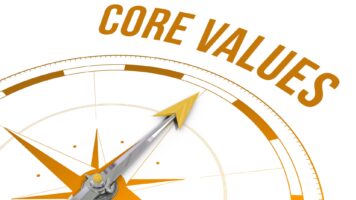Blind Spots

Anyone who drives has undoubtedly experienced a blind spot. It is a humbling and frightening moment the first time you change lanes, only to narrowly escape hitting a car that had been obscured from view. You quickly learn exactly what you have to do to check for a full field of vision before changing lanes the next time.
We often hear the term blind spot with respect to an obstruction in the field of vision, or an area in which one fails to exercise judgment in an ethical dilemma. But I could see neither an obstruction of the field or an ethical dilemma when I recently witnessed a colleague experiencing a “blind spot moment.”
Rick and I were taking a break from working with clients on the patio of their high-rise building, noticing how the leaves had suddenly appeared on the trees in the distance. Because workers were beginning to make some repairs on the building, I noticed that they had set up scaffolding, ropes, and pulleys to scale the exterior. A rope was hanging some 10 feet away from my colleague, Rick. I commented on the presence of the rope, and he scanned his field of vision, not able to see it. Because he was focused on the distance where we had been looking, he literally could not find the rope.
What struck me was this: not only could he not see something that was 10 feet away and unobstructed from his field of vision, but he was certain that he was seeing everything that was there to see. I suggested that he stop for just a moment to notice what his “certainty” felt like, so that he could call on that experience later. When he saw the rope hanging in obvious sight, he simply could not believe his eyes.
Rick’s blind spot had not occurred from any physical obstruction; it resulted more from a matter of focus. His selective attention played a trick on his awareness. Research shows that we scan what we are looking for and are often oblivious to others. For instance, Chabris and Simon conducted well-known studies about how selective attention can make us blind to the unexpected. In one study, they asked spectators to count the number of times basketball players in white shirts pass the ball to each other. Most observers were so focused on achieving accuracy in their assigned task, they completely missed seeing a black gorilla that walked among the players on the court.
Even though we believe that we see the world and ourselves as they are, are we actually missing things entirely? How often are we as leaders so certain that we see the whole picture, only to discover later that we had costly blind spots?
That’s where the awareness of the ideal process of learning can be an antidote. Our learning preferences—learning style—for how we navigate the process of learning—the learning cycle—offer clues to what will have our selective attention and what we might avoid. This unique way of building self-awareness and awareness of others allows us to identify our habitual focus, and to decrease blind spots in others and us.
Take Luke, who prefers the Analyzing style. He seeks structure, organization, and detailed information. Luke is more likely to first see the details in any situation and notice a potential problem, long before he will spot a new opportunity or see the big picture. This is in contrast to Sofia, who prefers the opposite Initiating style. Her ability to scan for new opportunities without worrying about the details or deliberating about the risk involved has allowed her to seize more opportunities than she has lost. In the process, Sophia may miss important details or problems that loom just beneath the surface, in her quest for the upside potential of the new possibility. It’s easy to see how Luke and Sophia actually need each other to see the whole picture.
Through this awareness, Luke and Sophia can be aware of their habitual preferences for “seeing” certain aspects of a situation and illuminating their potential “blind spots.” In my colleague Rick’s case, he was firmly focused on certainty, with curiosity out of his awareness. If you find that your focus leaves you without a 360° view, try using a learning approach. By understanding the entire learning cycle and adding all of the styles to your repertoire, you will balance the need for certainty with the equally important need for curiosity: content with context, feelings with facts, and internal sense-making with external action. And remember, unless your vision is a perfect 20/20, we need each other to see the whole picture.
The nine learning styles and the learning cycle process are described in the book How You Learn Is How You Live: Using Nine Ways of Learning to Transform Your Life by Kay Peterson and David A. Kolb, published by Berrett-Koehler.





